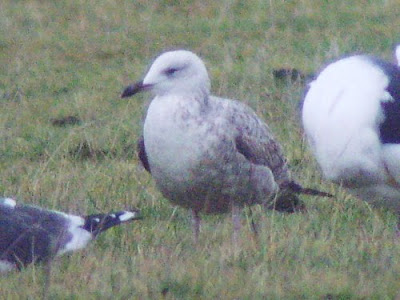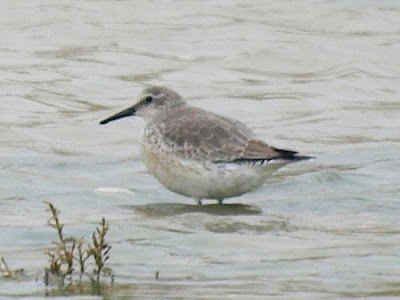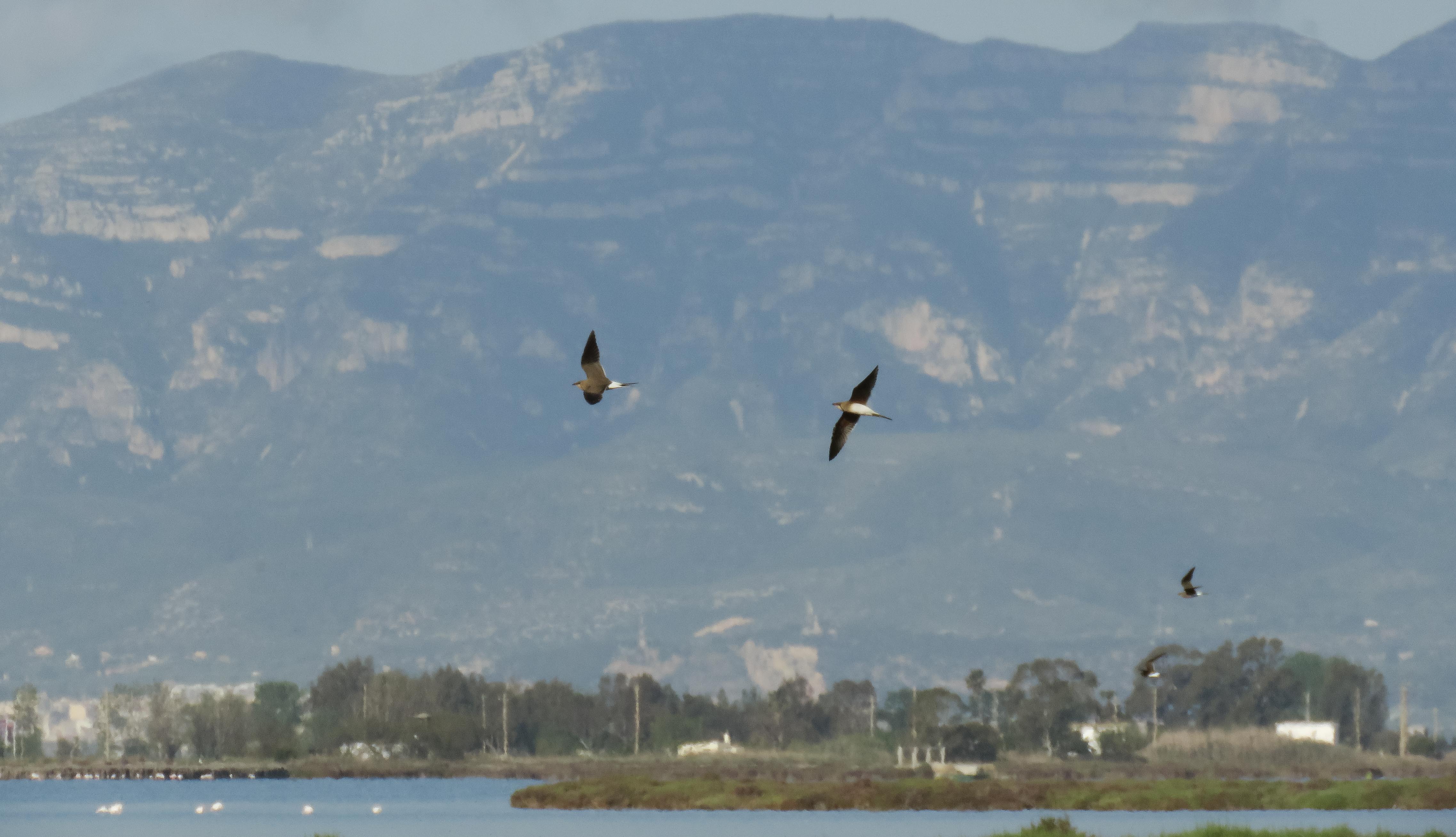Diver sp. 3W
Red-throated Diver 1E
Great Crested Grebe 1E, 1 on sea
Cormorant 11E, 52W
Gannet 9E, 25
Brent Geese 25E
Wigeon 1E
Oystercatcher 11
Common Gull c.100
Auk sp. 51E, 48W
Razorbill 62E, c.50 on sea
Rock Pipit 1
Skylark 40
Long-tailed Tit c.8
Sunday, 30 January 2011
Saturday, 29 January 2011
29th January 2011 Birling Gap 7.35am - 10.05am NE2 Overcast & Cuckmere
Red-throated Diver 70E, 25 on sea
Great Crested Grebe 1W, 9 on sea
Slavonian Grebe 2-3 ex. off Birling
Gannet 5E, 50
Cormorant 10E, 130 on sea in a single raft
Brent Goose 45E
Shelduck 1 on sea
Wigeon 2E, 6W
Gadwall 1E
Teal 5E
Scoter 4E
Oystercatcher 25
Curlew 5E
Kittiwake c.30
Herring Gull 7E adults s/p
Common Gull c.400
Auk sp. 5E, 63W
Razorbill 22E, c.200 on sea
Guillemot 3 on sea
Rock Pipit 1
Cuckmere
Little Egret 2
Dark-bellied Brent 2
White-fronted Goose 79 including the orange-billed juvenile still present
Barnacle Goose c.25


 Little Egret in the Cuckmere
Little Egret in the Cuckmere
Sunday, 23 January 2011
23rd January 2011 Birling Gap 7.45am - 9.15am N1 Overcast, Shinewater & Cuckmere
Red-throated Diver 12E, 8W
Great Crested Grebe 1W, 5 on sea
Cormorant 20E, 2W
Fulmar c.8
Gannet 6E, 114W to a large feeding congregation
Peregrine 1 male
Auk sp. 41E, 60W
Razorbill 442E, 40W
Curlew 2
Oystercatcher 6
Lesser Black-backed Gull 2 intermedius
Kittiwake 15W (mostly 1w)
Skylark 25
Raven 1
Shinewater
Little Egret 2
Bearded Tit 5+
Cuckmere
White-fronted Goose c.60
Barnacle Goose c.30
Great Crested Grebe 1W, 5 on sea
Cormorant 20E, 2W
Fulmar c.8
Gannet 6E, 114W to a large feeding congregation
Peregrine 1 male
Auk sp. 41E, 60W
Razorbill 442E, 40W
Curlew 2
Oystercatcher 6
Lesser Black-backed Gull 2 intermedius
Kittiwake 15W (mostly 1w)
Skylark 25
Raven 1
Shinewater
Little Egret 2
Bearded Tit 5+
Cuckmere
White-fronted Goose c.60
Barnacle Goose c.30
The only adult present sporting a pale eye-ring.
Note the orange-billed juvenile on the left
An interesting orange-billed juvenile. Close inspection of the bill unfortunately suggested some pinkish hues in the subterminal area. Furthermore, there are no obvious structural or plumage differences to suggest anything other than it being an Eurasian White-fronted Goose. In fact, its conical bill, pale-fringed tertials and broad white border and tips to its tail all support its identification as an Eurasian.
Saturday, 22 January 2011
22nd January 2011 Birling Gap 7.45am - 9.15am N2 Overcast, Shinewater & Newhaven Tide Mills
Red-throated Diver 5E, 1 on sea
Great Crested Grebe 1E, 1W, 2 on sea
Fulmar c.8
Gannet 10E, 5W, c.40 on sea
Cormorant 7W
Teal 3E
Razorbill 296E, 210W, 5 on sea
Guillemot 3E, 3W
Auk sp. 50E, 20W
Lesser Black-backed Gull 3 adult intermedius
Greater Black-backed Gull c.100
Common Gull c.800
Black-headed Gull 35W, c.30 on beach
Kittiwake 4E, 5W
Curlew 1E, 2W
Great Crested Grebe 1E, 1W, 2 on sea
Fulmar c.8
Gannet 10E, 5W, c.40 on sea
Cormorant 7W
Teal 3E
Razorbill 296E, 210W, 5 on sea
Guillemot 3E, 3W
Auk sp. 50E, 20W
Lesser Black-backed Gull 3 adult intermedius
Greater Black-backed Gull c.100
Common Gull c.800
Black-headed Gull 35W, c.30 on beach
Kittiwake 4E, 5W
Curlew 1E, 2W
Shinewater, Eastbourne
Little Egret 1
Bittern 1 fvo
Bearded Tit 7
Newhaven Tide Mills
Knot 2
Saturday, 15 January 2011
15th January 2011 Rainham Marshes
Scandinavian Herring Gull c.50
Herring Gull 1 leucistic - the red-ringed individual previously seen at Beachy Head last Spring!
Lesser Black-backed Gull c.200
Ring-necked Parakeet 2
Sunday, 9 January 2011
9th January 2011 Birling Gap 8am - 9am W2 Sunny, Shinewater & Cuckmere
Red-throated Diver 2E, 4W
Gannet 11E, 11W
Fulmar 1E, 2W
Cormorant 1E, 5W
Common Gull c.50
Kittiwake 2E, 12W
Razorbill 22W
Auk sp. 1E, 18W
Red-legged Partridge 1
Curlew 1W
Starling c.250
Skylark 2W, 50
Meadow Pipit 3
House Sparrow 15
Goldfinch 5
Linnet 2
 Jackdaw at Belle Tout
Jackdaw at Belle Tout Common Gulls on Birling Gap beach
Common Gulls on Birling Gap beachShinewater, Eastbourne
Slavonian Grebe 1 w/p ex.
Smew 1 redhead
Mediterranean Gull 1 1st-w

First-winter Mediterranean Gull at Shinewater


Upper Cuckmere
Great Black-backed Gull c.50
Egyptian Goose 6
White-fronted Goose 68
White-fronted Goose 68
Barnacle Goose 11
Yellowhammer 1
Saturday, 8 January 2011
8th January 2011 Birling Gap SW6 8am - 10am Overcast with some rain & Cuckmere
Diver sp. 2W
Cormorant 2W
Gannet 40E, 52W
Fulmar 12E, 12W, 4 sat on sea
Brent 10E
Common Gull c.75
Kittiwake 5E, 40W
Bonxie 1E at 8.45am
Auk sp. 1E, 1W, 15 sat on sea
Guillemot 1W
Razorbill 1W
Oystercatcher 4E
Great Spotted Woodpecker 1
Skylark 50
Meadow Pipit 2
Long-tailed Tit 6
Goldfinch 5
 Female Great Spotted Woodpecker in Belle Tout Wood
Female Great Spotted Woodpecker in Belle Tout Wood
 Long-tailed Tit in Belle Tout Wood
Long-tailed Tit in Belle Tout Wood


 ... or gorseland destruction at Beachy Head at the very site that played host to a pair of Dartford Warblers last Autumn. Do we really need any more sterile grassland?
... or gorseland destruction at Beachy Head at the very site that played host to a pair of Dartford Warblers last Autumn. Do we really need any more sterile grassland?
Cuckmere Haven
 First-winter Caspian Gull Larus cachinnans in the Upper Cuckmere
First-winter Caspian Gull Larus cachinnans in the Upper Cuckmere

 First-winter Caspian Gull Larus cachinnans in the Upper Cuckmere
First-winter Caspian Gull Larus cachinnans in the Upper Cuckmere

 First-winter Caspian Gull Larus cachinnans in the Upper Cuckmere
First-winter Caspian Gull Larus cachinnans in the Upper Cuckmere
 First-winter Caspian Gull Larus cachinnans in the Upper Cuckmere
First-winter Caspian Gull Larus cachinnans in the Upper Cuckmere
 First-winter Caspian Gull Larus cachinnans in the Upper Cuckmere
First-winter Caspian Gull Larus cachinnans in the Upper Cuckmere
When alert, it was noticeably long-necked, topped by the peculiarly small and narrow skeletal head of this species.

 First-winter Caspian Gull Larus cachinnans in the Upper Cuckmere
First-winter Caspian Gull Larus cachinnans in the Upper Cuckmere
At distance its long slender bill appeared predominantly black tapering to its tip and lacking a visible gonys-angle and quite different to the stout bulky bills typical of Yellow-legged Gull.
 First-winter Caspian Gull Larus cachinnans in the Upper Cuckmere (Matt Eade)
First-winter Caspian Gull Larus cachinnans in the Upper Cuckmere (Matt Eade)
 First-winter Caspian Gull Larus cachinnans in the Upper Cuckmere (Matt Eade)
First-winter Caspian Gull Larus cachinnans in the Upper Cuckmere (Matt Eade)
 First-winter Caspian Gull Larus cachinnans in the Upper Cuckmere (Matt Eade)
First-winter Caspian Gull Larus cachinnans in the Upper Cuckmere (Matt Eade)


Cormorant 2W
Gannet 40E, 52W
Fulmar 12E, 12W, 4 sat on sea
Brent 10E
Common Gull c.75
Kittiwake 5E, 40W
Bonxie 1E at 8.45am
Auk sp. 1E, 1W, 15 sat on sea
Guillemot 1W
Razorbill 1W
Oystercatcher 4E
Great Spotted Woodpecker 1
Skylark 50
Meadow Pipit 2
Long-tailed Tit 6
Goldfinch 5
 Female Great Spotted Woodpecker in Belle Tout Wood
Female Great Spotted Woodpecker in Belle Tout Wood Long-tailed Tit in Belle Tout Wood
Long-tailed Tit in Belle Tout Wood

 ... or gorseland destruction at Beachy Head at the very site that played host to a pair of Dartford Warblers last Autumn. Do we really need any more sterile grassland?
... or gorseland destruction at Beachy Head at the very site that played host to a pair of Dartford Warblers last Autumn. Do we really need any more sterile grassland?Cuckmere Haven
Barnacle Goose c.8
Caspian Gull 1w ex. (12.30pm - 1.35pm)
Lesser Black-backed Gull c.30 (both graeslii & intermedius)
Great Black-backed Gull c.1,000
Mistle Thrush 1
 First-winter Caspian Gull Larus cachinnans in the Upper Cuckmere
First-winter Caspian Gull Larus cachinnans in the Upper Cuckmere Its white head and breast, silvery-grey scapulars and mantle, brownish coverts and long black primaries all combine to make this a 'four-coloured' Gull. Immediately visible pro-Caspian Gull features include its white head, its long sloping forehead, flat crown, slender bill with its almost white base to its lower mandible and bill's pale basal two-thirds with its black tip bleeding along its cutting edge, long gape-line, small black eye and necklace of dark streaking. Its pale pink legs appear clearly thin and rather weak looking for the size of the bird.

First-winter Caspian Gull Larus cachinnans in the Upper Cuckmere
Face-on it would appear small-headed especially when compared to its bulging neck both uniquely characteristic of this 'large white-headed Gull'.
 First-winter Caspian Gull Larus cachinnans in the Upper Cuckmere
First-winter Caspian Gull Larus cachinnans in the Upper Cuckmere This image shows it continuous white area consisting of its head, centre to its kinked neck, centre of its breast extending onto its belly. It also shows the extent of the streaking to its neck-sides and mottling on its flanks. It is typical for first-winters to retain the dark markings to their breast-sides. For a similarly marked January first-winter see the bottom image obtained by Steve Arlow on:

 First-winter Caspian Gull Larus cachinnans in the Upper Cuckmere
First-winter Caspian Gull Larus cachinnans in the Upper CuckmereThese images nicely portray its pure white pear-shaped head, long white loral area, gape-line and white eye-lids lacking any hint of the dark mask of a Yellow-legged Gull, clean white centre to its breast and white belly. It also shows the extent of its long-neck and a hint of the protruding neck of this species. Even at these angles it fails to hide its long black primaries!
 First-winter Caspian Gull Larus cachinnans in the Upper Cuckmere
First-winter Caspian Gull Larus cachinnans in the Upper CuckmereWhen its all-white head was viewed side-on the combination of its slender bill lacking an obvious gonys-angle, long sloping forehead, flat crown and angled hindneck all combined to convey the charismatic 'classic' pear-shaped headshape of this species.
 First-winter Caspian Gull Larus cachinnans in the Upper Cuckmere
First-winter Caspian Gull Larus cachinnans in the Upper CuckmereWhen alert, it was noticeably long-necked, topped by the peculiarly small and narrow skeletal head of this species.

First-winter Caspian Gull Larus cachinnans in the Upper Cuckmere
Small dark spots on its lower hindneck created a dark necklace being most prominent on its hindneck.
 First-winter Caspian Gull Larus cachinnans in the Upper Cuckmere
First-winter Caspian Gull Larus cachinnans in the Upper CuckmereAt distance its long slender bill appeared predominantly black tapering to its tip and lacking a visible gonys-angle and quite different to the stout bulky bills typical of Yellow-legged Gull.
 First-winter Caspian Gull Larus cachinnans in the Upper Cuckmere (Matt Eade)
First-winter Caspian Gull Larus cachinnans in the Upper Cuckmere (Matt Eade)Viewed from more side-on the broad tips to its dark greater coverts create a visibly broad pale wing-bar.
 First-winter Caspian Gull Larus cachinnans in the Upper Cuckmere (Matt Eade)
First-winter Caspian Gull Larus cachinnans in the Upper Cuckmere (Matt Eade) Its first-winter silvery-grey lower scapulars had feint narrow darker grey shaft streaks with broader subterminal anchor-shaped markings whilst some of its upper scapulars had blackish diamond-shaped centres. Its silvery-grey scapulars are in contrast to its distinctly brownish coverts. It did not appear to have replaced any juvenile coverts in this respect again similar to the first-winter in the lowest image obtained by Steve Arlow here:
 First-winter Caspian Gull Larus cachinnans in the Upper Cuckmere (Matt Eade)
First-winter Caspian Gull Larus cachinnans in the Upper Cuckmere (Matt Eade)Side-on the all-important worn brown-centred tertails with pale 'thumbnail-like' pale tips are revealed. The solid dark bases and broad white tips to the greater coverts are obvious. A less conspicuous pale wingbar is formed by the white tips of its median coverts. Its long primary projection illustrated by the distance from its tail-tip to its wing tip being greater than the distance between the tip of its longest tertial and its tail-tip (equal to or slightly greater in Yellow-legged and equal to or slightly shorter in Herring). Being completely side-on it is possible to appreciate its elongated appearance at times all but lacking a tertial step.
On stretching it revealed soft white axilliaries, its predominently white underwing coverts and the tail pattern consisting of its strikingly white tail-base and sharply demarcated broad black tail band. This rather 'clinched the deal' for the observers present.


First-winter Caspian Gull Larus cachinnans in the Upper Cuckmere (Matt Eade)
In flight, Caspian Gulls are often described as appearing hump-backed and showing a long arm. The oft-quoted 'double white wing bar of the species' formed by the pale tips of median and greater coverts is shown to good effect as is its white tail-base contrasting against its solid black tail-bar - it lacks the striking white terminal band of a first-winter Yellow-legged Gull. A pale window was readily apparent on its inner primaries approaching that of a Herring Gull being more distinct than on Yellow-legged Gull. The images reveal the 'venetian blind' effect created by the darker outer webs contrasting with the pale inner webs of each primary. The outer web of p1 is clearly wholly black - being pale on Herring Gull. An extensive pale cigar-shaped lozenge is just visible on the outer web of p2 and clearly visible on the outer web of p3 - these are often lacked by Yellow-legged Gulls or smaller and less prominent. As it flew past the gathered observers, RDME remarked on its silvery-grey mantle and scapulars giving it the impression of appearing 'older' than any other regularly encountered first-winter 'large white-headed Gull'. Note the similarity of these upperwing shots, and especially the 'arrowhead markings' on the side of the lower back on the scapulars with the image of a first-winter obtained by Steve Arlow (fourth from top) at:
Here it appears very long-winged and in contrast to the wing-stretching image above it gives the appearance of its underwings appearing somewhat browner. However, close scrutiny shows that virtually all of the feathers of it axilliaries and underwing-coverts are in fact white-(or at least pale-)centred with brown edges (click on image to enlarge). Whilst clearly not gleaming-white(!), the underwings do appear quite silvery and the 'pale window' of the inner primaries can still be determined. Observations in Romania indicate some Caspian Gulls can have quite well-marked underwings, with dark brown barring and spotting across many feathers, especially the lesser underwing-coverts and axillaries. Its undertail-coverts were white with a line of black markings along their sides. For a late January first-winter with darker markings on its underwings see the top image at:
http://www.birdersplayground.co.uk/Caspian%20Gulls%201st%20years%20-%20flight%20images.html
http://www.birdersplayground.co.uk/Caspian%20Gulls%201st%20years%20-%20flight%20images.html
River Ouse, Newhaven
Little Grebe 1
Common Sandpiper 1
Subscribe to:
Posts (Atom)




































